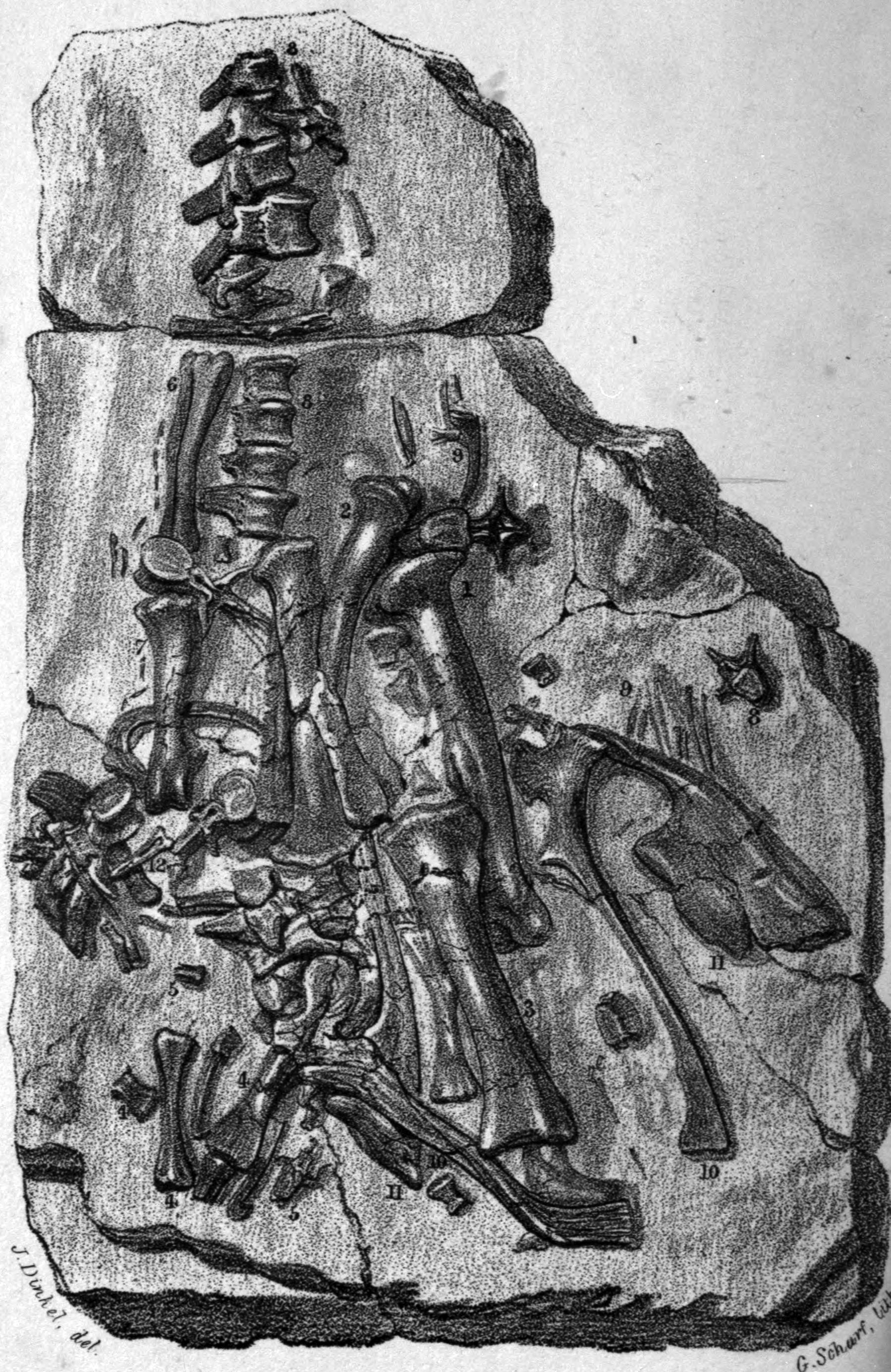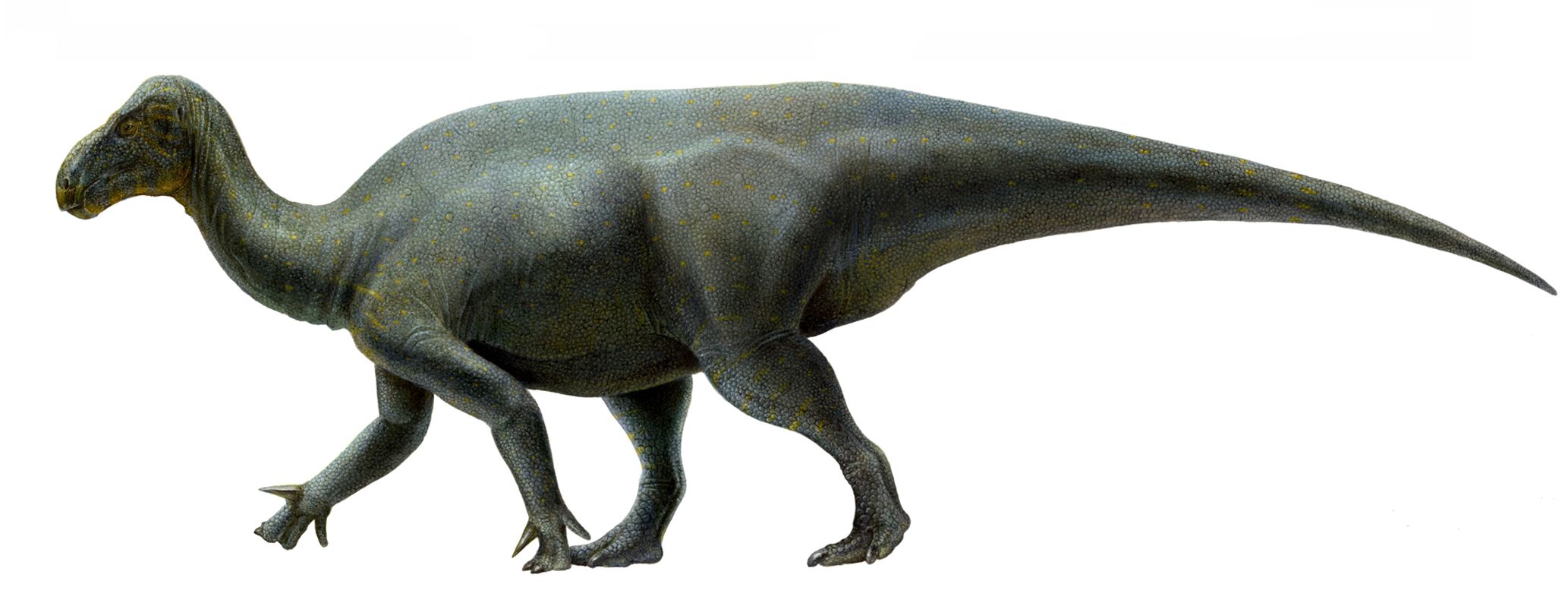|
Iguanodontidae
Iguanodontidae is a family of iguanodontians belonging to Styracosterna, a derived clade within Ankylopollexia. The clade is formally defined in the ''PhyloCode'' by Daniel Madzia and colleagues in 2021 as "the largest clade containing '' Iguanodon bernissartensis'', but not '' Hadrosaurus foulkii''". Characterized by their elongated maxillae, they were herbivorous and typically large in size. This family exhibited locomotive dynamism; there exists evidence for both bipedalism and quadrupedalism within iguanodontid species, supporting the idea that individual organisms were capable of both locomoting exclusively with their hind limbs and locomoting quadrupedally. Iguanodontids possess hoof-like second, third, and fourth digits, and in some cases, a specialized thumb spike and an opposable fifth digit. Their skull construction allows for a strong chewing mechanism called a transverse power stroke. This, paired with their bilateral dental occlusion, made them extremely effective ... [...More Info...] [...Related Items...] OR: [Wikipedia] [Google] [Baidu] |
Iguanodon Bernissartensis
''Iguanodon'' ( ; meaning 'iguana-tooth'), named in 1825, is a genus of iguanodontian dinosaur. While many species found worldwide have been classified in the genus ''Iguanodon'', dating from the Late Jurassic to Early Cretaceous, Taxonomy (biology), taxonomic revision in the early 21st century has defined ''Iguanodon'' to be based on one well-substantiated species: ''I. bernissartensis'', which lived during the Barremian to early Aptian ages of the Early Cretaceous in Belgium, Germany, England, and Spain, between about 126 and 122 million years ago. ''Iguanodon'' was a large, bulky herbivory, herbivore, measuring up to in length and in body mass. Distinctive features include large thumb spikes, which were possibly used for defense against predation, predators, combined with long prehensile fifth fingers able to forage for food. The genus was named in 1825 by English geologist Gideon Mantell, based on fossil specimens found in England and was given the species name ''I. ... [...More Info...] [...Related Items...] OR: [Wikipedia] [Google] [Baidu] |
Lurdusaurus
''Lurdusaurus'' ("heavy lizard") is a genus of massive and unusually shaped iguanodont dinosaur from the Elrhaz Formation in Niger. It contains one species, ''L. arenatus''. The formation dates to the Early Cretaceous, roughly 112 million years ago. ''Lurdusaurus'' has a highly atypical body plan for an iguanodont, with a small skull, long neck, rotund torso, and powerful forelimbs and claws, somewhat reminiscent of a ground sloth. Its metacarpals (wrist bones) are fused and reinforced into a large block, and the thumb spike is remarkably enormous. These would have allowed the hand to have functioned almost like a ball-and-chain flail. ''Lurdusaurus'' is estimated to have been long and high when on all-fours, but its stomach would have been only off the ground. It may have weighed , conspicuously heavy for an iguanodontid this size. Paleontologist Thomas R. Holtz Jr. speculated ''Lurdusaurus'' may have behaved much like a hippo. It lived in a forested, riverine environment ... [...More Info...] [...Related Items...] OR: [Wikipedia] [Google] [Baidu] |
Iguanodontia
Ornithopoda () is a clade of ornithischian dinosaurs, called ornithopods (). They represent one of the most successful groups of herbivorous dinosaurs during the Cretaceous. The most primitive members of the group were bipedal and relatively small-sized, while advanced members of the subgroup Iguanodontia became quadrupedal and developed large body size. Their major evolutionary advantage was the progressive development of a chewing apparatus that became the most sophisticated ever developed by a non-avian dinosaur, rivaling that of modern mammals such as the domestic cow. They reached their apex of diversity and ecological dominance in the hadrosaurids (colloquially known as 'duck-bills'), before they were wiped out by the Cretaceous–Paleogene extinction event along with all other non- avian dinosaurs. Members are known worldwide. History of research In 1870, Thomas Henry Huxley listed Iguanodontidae (coined by Edward Drinker Cope a year earlier) as one of his three famil ... [...More Info...] [...Related Items...] OR: [Wikipedia] [Google] [Baidu] |
Proa Valdearinnoensis
''Proa'' is a genus of basal styracosternan iguanodont known from the Early Cretaceous Escucha Formation (lower Albian stage) of Teruel Province, Spain. Discovery and naming It contains a single species, ''Proa valdearinnoensis''. The generic name is from the Spanish word "proa" (meaning "prow"), which alludes to the pointed shape of the animal's predentary bone; while the specific name is derived from Val de Ariño, the traditional name for the coal mines near where the first fossils were found. The animal was described on the basis of three partial skeletons and several skull elements from different individuals. Description ''Proa'' is distinguished from other basal hadrosauriforms (especially other iguanodontids) in having a predentary that reaches the rostral margin, with divergent lateral processes. It can also be diagnosed by a unique combination of characters: dentary tooth row convex dorsally in lateral view; dentary tooth row extending caudal to the base of the coronoi ... [...More Info...] [...Related Items...] OR: [Wikipedia] [Google] [Baidu] |
Styracosterna
Ankylopollexia is an extinct clade of ornithischian dinosaurs that lived from the Late Jurassic to the Late Cretaceous. It is a derived clade of iguanodontian ornithopods and contains the subgroup Styracosterna. The name stems from the Greek word, “ankylos”, mistakenly taken to mean stiff, fused (in fact the adjective means bent or curved; used of fingers, it can mean hooked), and the Latin word, “pollex”, meaning thumb. Originally described in 1986 by Sereno, a most likely synapomorphic feature of a conical thumb spine defines the clade.Sereno, P.C. (1986). "Phylogeny of the bird-hipped dinosaurs (order Ornithischia)". National Geographic Research 2 (2): 234–56 First appearing around 156 million years ago, in the Jurassic, Ankylopollexia became an extremely successful and widespread clade during the Cretaceous, and were found around the world. The group died out at the end of the Maastrichtian. They grew to be quite large, comparable to some carnivorous dinosaurs and t ... [...More Info...] [...Related Items...] OR: [Wikipedia] [Google] [Baidu] |
Comptonatus
''Comptonatus'' (meaning "the Compton thunderer") is a genus of ornithopod dinosaur from the early Cretaceous period. Its remains are known from the Wessex Formation in England. The type and only species is ''C. chasei''. Discovery and naming The holotype specimen, IWCMS 2014.80, was excavated in September–October 2013, close to where a ''Valdosaurus'' specimen was recovered the previous year. It is the most complete ornithopod dinosaur found on the Isle of Wight since ''Mantellisaurus'' in 1914. ''Comptonatus'' was described as a new genus and species of iguanodontian dinosaur in 2024. The generic name, ''Comptonatus'', combines the name of the location Compton with the Latin ''tonatus'', meaning "thundered", and has the intended meaning of "the Compton thunderer", in reference to its discovery location and large size. The specific name, ''chasei'', honours the late Nick Chase, who won the Palaeontological Association's Mary Anning Award in 2018 and discovered the speci ... [...More Info...] [...Related Items...] OR: [Wikipedia] [Google] [Baidu] |
Ankylopollexia
Ankylopollexia is an extinct clade of ornithischian dinosaurs that lived from the Late Jurassic to the Late Cretaceous. It is a derived clade of iguanodontian ornithopods and contains the subgroup Styracosterna. The name stems from the Greek word, “ankylos”, mistakenly taken to mean stiff, fused (in fact the adjective means bent or curved; used of fingers, it can mean hooked), and the Latin word, “pollex”, meaning thumb. Originally described in 1986 by Sereno, a most likely synapomorphic feature of a conical thumb spine defines the clade.Sereno, P.C. (1986). "Phylogeny of the bird-hipped dinosaurs (order Ornithischia)". National Geographic Research 2 (2): 234–56 First appearing around 156 million years ago, in the Jurassic, Ankylopollexia became an extremely successful and widespread clade during the Cretaceous, and were found around the world. The group died out at the end of the Maastrichtian. They grew to be quite large, comparable to some carnivorous dinosaurs an ... [...More Info...] [...Related Items...] OR: [Wikipedia] [Google] [Baidu] |
Jinzhousaurus
''Jinzhousaurus'' is a genus of hadrosauroid dinosaur of the Early Cretaceous of China. The type species is ''Jinzhousaurus yangi''. The generic name refers to the town Jinzhou. The specific name honours Yang Zhongjian is the founder of Chinese paleontology. It was first described by Wang Xiao-lin and Xu Xing in 2001. Discovery Its fossil, holotype IVPP V12691, was found near Baicaigou in Yixian County in the Dawangzhangzi Beds of the Yixian Formation in Liaoning, China, having an oldest determinable age of 122 million years, during the early Aptian stage of the early Cretaceous Period.Zhou, Z. (2006). "Evolutionary radiation of the Jehol Biota: chronological and ecological perspectives." ''Geological Journal'', 41: 377-393. It consists of a nearly complete skeleton, compressed on a slab. Description ''Jinzhousaurus'' has a length of about 7 metres (23 ft) and its skull is about half a metre long. Its snout was elongated with large nares and lacking an antorbital fen ... [...More Info...] [...Related Items...] OR: [Wikipedia] [Google] [Baidu] |
Phylogeny
A phylogenetic tree or phylogeny is a graphical representation which shows the evolutionary history between a set of species or Taxon, taxa during a specific time.Felsenstein J. (2004). ''Inferring Phylogenies'' Sinauer Associates: Sunderland, MA. In other words, it is a branching diagram or a tree (graph theory), tree showing the evolutionary relationships among various biological species or other entities based upon similarities and differences in their physical or genetic characteristics. In evolutionary biology, all life on Earth is theoretically part of a single phylogenetic tree, indicating common ancestry. Phylogenetics is the study of phylogenetic trees. The main challenge is to find a phylogenetic tree representing optimal evolutionary ancestry between a set of species or taxa. computational phylogenetics, Computational phylogenetics (also phylogeny inference) focuses on the algorithms involved in finding optimal phylogenetic tree in the phylogenetic landscape. Phylogene ... [...More Info...] [...Related Items...] OR: [Wikipedia] [Google] [Baidu] |
Paraphyletic
Paraphyly is a taxonomic term describing a grouping that consists of the grouping's last common ancestor and some but not all of its descendant lineages. The grouping is said to be paraphyletic ''with respect to'' the excluded subgroups. In contrast, a monophyletic grouping (a clade) includes a common ancestor and ''all'' of its descendants. The terms are commonly used in phylogenetics (a subfield of biology) and in the tree model of historical linguistics. Paraphyletic groups are identified by a combination of synapomorphies and symplesiomorphies. If many subgroups are missing from the named group, it is said to be polyparaphyletic. The term received currency during the debates of the 1960s and 1970s accompanying the rise of cladistics, having been coined by zoologist Willi Hennig to apply to well-known taxa like Reptilia (reptiles), which is paraphyletic with respect to birds. Reptilia contains the last common ancestor of reptiles and all descendants of that ancestor exc ... [...More Info...] [...Related Items...] OR: [Wikipedia] [Google] [Baidu] |
Hadrosauridae
Hadrosaurids (), also hadrosaurs or duck-billed dinosaurs, are members of the ornithischian family Hadrosauridae. This group is known as the duck-billed dinosaurs for the flat duck-bill appearance of the bones in their snouts. The ornithopod family, which includes genera such as '' Edmontosaurus'' and '' Parasaurolophus'', was a common group of herbivores during the Late Cretaceous Period. Hadrosaurids are descendants of the Late Jurassic/Early Cretaceous iguanodontian dinosaurs and had a similar body layout. Hadrosaurs were among the most dominant herbivores during the Late Cretaceous in Asia and North America, and during the close of the Cretaceous several lineages dispersed into Europe, Africa, and South America. Like other ornithischians, hadrosaurids had a predentary bone and a pubic bone which was positioned backwards in the pelvis. Unlike more primitive iguanodonts, the teeth of hadrosaurids are stacked into complex structures known as dental batteries, which acted as e ... [...More Info...] [...Related Items...] OR: [Wikipedia] [Google] [Baidu] |






